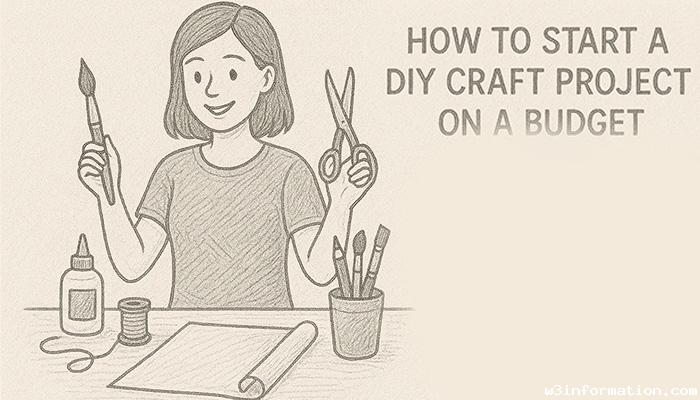How to Start a DIY Craft Project on a Budget
Crafting represents a great outlet for creative expression and relaxation while allowing you to produce unique items for yourself or your family. People often find it intimidating to begin a DIY craft project when they have limited funds. Crafting activities can be completed without incurring high costs. Through careful planning and innovative thinking you can produce attractive and practical objects without spending too much money. This blog will explain how to begin a budget-friendly DIY craft project by providing advice on material sourcing and utilizing existing home supplies along with ideas for economical projects.
Choose Simple Projects
Begin your budget-friendly DIY project by selecting a project that operates with affordable materials and basic tools. You can create some craft ideas by using only a few basic supplies and minimal equipment.
a. Upcycled Crafts
Turning unused household possessions into new creations helps you save money while achieving distinctiveness. You can use glass jars as candle holders, convert old t-shirts into tote bags, or change wooden crates into shelves. Upcycling offers financial savings and creates environmentally sustainable results.
b. Simple Paper Crafts
Paper crafts are inexpensive and versatile. With just a few basic supplies including colored paper, glue, scissors and markers anyone can create greeting cards, paper flowers or wall art. Beginners can easily start paper crafting since it requires only a minimal financial investment for materials.
c. Knitting or Crocheting
Basic knitting and crocheting techniques require only affordable yarn and fundamental needles. You can make scarves or hats and decorate your home with easy DIYs like pillow covers and blankets. Begin with low-cost projects to develop your skills without spending on pricey materials.

Source Materials on a Budget
After choosing your project you need to collect all necessary materials. You can obtain inexpensive supplies for your DIY craft project by finding creative ways to reuse items from home or making smart purchasing decisions.
a. Repurpose Materials You Already Have
Search your home for items you no longer require before purchasing new materials. Unused furniture alongside broken jewelry and old clothes provides good opportunities for transformation into new products. By repurposing scrap fabric you can make quilts or transform an old bracelet into a new necklace.
b. Shop at Thrift Stores and Dollar Stores
Thrift stores along with secondhand shops and dollar stores present a wealth of affordable crafting supplies. Fabric, picture frames, buttons, vases along with numerous other items sell at bargain prices. Watch for objects which you can transform through upcycling or repurposing into your creative project.
c. Use Free Printables and Templates
Numerous free resources on the internet can provide assistance for your DIY endeavors. A range of websites provide free templates and patterns for various craft projects including scrapbooking and home décor. You avoid costly purchases for elaborate designs and patterns by using this technique.
d. Bulk Buying
Consider purchasing supplies in bulk when you intend to work on many craft projects or need to build up your material inventory. Many craft stores and online retailers provide discounts to customers who buy materials in larger amounts. People save money by purchasing yarn, beads, and fabric in bulk quantities.
Be Creative with Tools
DIY project expenses often peak at tools but gorgeous crafts can be made without purchasing costly equipment. These tips will guide you in maintaining minimal expenses:
a. Use Household Items as Tools
Household items provide a cost-effective replacement for many expensive craft tools. Repurpose common items by using kitchen scissors instead of fabric scissors and measure with a pencil and ruler instead of fancy tools. A plastic spoon can serve as a clay molding tool while a butter knife works well for scraping tasks.
b. Borrow or Share Tools
If your project requires specific tools only temporarily consider asking friends or family to borrow them or propose a tool-sharing arrangement. A sewing machine might not be essential for one project but consider borrowing it from someone who owns one.
c. Multi-purpose Tools
Choose tools with multiple functions to reduce overall expenses. Scrapbooking projects and decoration making both benefit from hot glue guns while rotary cutters serve fabric and paper crafts.
Set a Realistic Budget
Establish a practical budget before beginning your DIY craft project and ensure you adhere to it. Working within a budget doesn’t require you to reduce quality or stop being creative because it involves planning ahead and paying attention to your needs.
a. Create a Shopping List
Write down all necessary supplies before leaving for shopping and attempt to adhere to this list. When you discover an unlisted necessary item for your project think about if you need to purchase it or whether a substitute from your existing supplies will suffice.
b. Look for Discounts and Coupons
Craft stores provide discounts and sales events on a regular basis throughout the year. Utilize these chances to purchase your supplies at discounted rates. Search online for discount codes or coupons to use with craft retailers that operate on the internet.
c. Track Your Spending
Monitoring your expenses helps you stay within your budget limits. Future project planning will become more efficient while unnecessary spending will decrease.
Explore Low-Cost Craft Ideas
Start with these budget-conscious crafts which need only a few basic supplies.
a. DIY Candles
Creating personalized gifts or home décor yourself is both enjoyable and affordable by making your own candles. The three main materials required to make candles are wax and a wick combined with affordable essential oils or colorants. Old candle jars provide perfect containers for crafting new candles.
b. Macramé Projects
Macramé is an affordable craft that needs nothing more than string or rope together with simple knots to create projects. With affordable materials such as cotton twine or yarn you can create decorations for walls or plants and also make jewelry.
c. Terrariums and Indoor Plants
The creation of a small indoor garden or terrarium provides an affordable way to enhance your living area with natural beauty. Old glass jars along with pebbles and small plants make perfect materials for crafting stunning decorative pieces. Home propagation of plants allows you to avoid spending large amounts on buying new plants.
d. Personalized Gifts
Handmade gifts maintain their value because they bring personal touch and they don’t require a large expense. Hand-painted mugs, custom picture frames and DIY jewelry serve as affordable gifts that show you care for family and friends.
Enjoy the Process
The essential element of DIY work is finding enjoyment throughout the creative journey. Crafting stands as a creative outlet which must deliver fun experiences while offering relaxation and rewarding feelings. Embrace the creative journey by letting go of the need for perfection and immediate success in your first attempt. Accept your creative flaws while taking pleasure in the journey of making something unique.
Conclusion: Budget DIY craft projects become achievable through careful planning and creative use of resources. You can create personalized beautiful items using simple projects and repurposed materials while keeping your spending in check. The main goal when crafting for personal use, home décor, or as gifts should be to find joy in the creative process and allow your imagination to take charge. These guidelines prepare you to begin your upcoming cost-effective DIY venture while letting your imagination take control.
 Top 10 Comfort Foods to Try This Winter
Top 10 Comfort Foods to Try This Winter
 Top 10 Christmas Destinations Around the World
Top 10 Christmas Destinations Around the World
 Navigating Adolescence: Tips for Parents and Teens
Navigating Adolescence: Tips for Parents and Teens
 How to Build Strong Family Bonds in the Digital Age
How to Build Strong Family Bonds in the Digital Age
 The Importance of Early Childhood Education
The Importance of Early Childhood Education